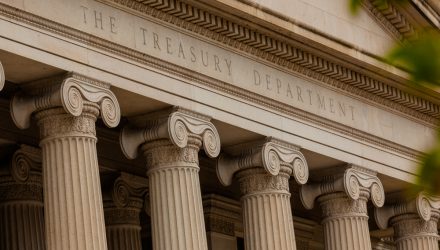A U.S. default would likely spur volatility in the Treasury and Treasury ETF markets, experts say. However, it likely wouldn’t cause a value crash for a cornerstone of the global financial system.
To be clear, a U.S. default has far larger consequences to the economy than volatility in the bond ETF markets. If Congress doesn’t raise the debt limit by the so-called “X-date” when the Treasury Department’s cash balance runs out and it can no longer pay the nation’s obligations, the U.S. could see a number of resulting scenarios. Political tensions over raising the debt limit boiled over on Friday as House Republicans walked out of a meeting with White House staff, calling negotiations “on pause.”
Possible Consequences
An immediate drop in the value of the dollar, volatility in the equity markets, furloughs to the federal workforce, delays in social program payments, and the long-term effects of a lower U.S. credit rating are just some of the possible outcomes.
A default also could inject turbulence into the markets that underlie approximately $563 billion in assets invested in ETFs primarily holding U.S. debt, according to figures from data provider Logicly. Those assets are spread across investor portfolios, institutional positions, and industries such as insurance companies. All of these use Treasuries as a liquid risk management tool.
The effects of a default depend on how exactly the federal government would operate once it hits the debt limit, and how quickly it raises the debt limit again.
The less-likely scenario is where markets believe the U.S. will fail to pay coupons on its outstanding debt. That’s akin to the water main bursting in the world’s financial plumbing system.
Lending costs would rise across the economy, stocks would sink after months of inflationary pressure and nerves around a recession. Moreover, balance sheets that rely on Treasurys for hedging or cash-flow purposes would scramble to find liquid, low-risk assets for collateral.
The playbook for corporate and sovereign defaults generally leads to the company or country involved negotiating with its creditors to write down the face value of the outstanding debt. But any kind of refinancing would be tricky. That’s because the International Monetary Fund, often seen as a lender of last resort for sovereign countries, receives 17% of its main source of funding from the U.S.
Speculation Potential
“The whole role of the U.S. in the world would be dramatically changed. I wouldn’t worry about an ETF at that point,” said Herbert Blank, a longtime ETF structure consultant.
Blank said Treasury ETF shares could continue to trade regardless of how much a default would affect the liquidity of its underlying assets. That unmooring could make fertile ground for speculators in a similar manner to what happened to U.S.-listed Russia-focused ETFs. The funds saw their underlying assets frozen by the U.S. in response to the invasion of Ukraine, which prompted a meme stock-like bout of volatility.
In another scenario, the U.S. could technically breach its debt cap but continue to pay debtholders through extraordinary short-term cuts. However, it’s not clear if the Treasury Department has the legal power to prioritize bond payments versus other types of payments.
Jim Cielinski, global head of fixed-income at Janus Henderson, notes T-bill yields are sharply higher for debt that matures between June and August. He believes the chance of a default is extremely low. If Congress was unable to increase the debt limit in time, the resulting panic in the markets would force a swift resolution. This would include a possible short-term increase.
“It’s almost unimaginable to think there would be a default. Still, it’s even more unimaginable to think that the investors wouldn’t be made whole,” he said.
VettaFi financial futurist Dave Nadig said hedge funds and arbitrage-driven buyers could come in to buy that debt at higher yields than short-term bonds normally demand. However, that strategy requires a strong risk tolerance.
“People will position themselves not to be bagholders,” he said.
ETF Boards Will Have Decisions to Make
For ETFs tracking those assets, the boards overseeing each fund would have to decide how to value the bonds they hold.
Nadig doesn’t expect those boards to mark their bond valuations to near-zero or zero. It would mean attracting the attention of arbitrage traders looking to take advantage of wide spreads. Instead, he expects them to make decisions on how much to mark down the value of those bonds. This, in turn, distorts the fund’s net asset value.
Cielinski also doesn’t expect large permanent writedowns if the X-date is reached. But he notes Treasurys and Treasury ETFs would likely become more volatile. That’s due to risk-avoidant sellers moving into the market with buyers willing to take on default risk. He also said a federal default will not look the same as a corporate default. He expects no losses to bondholders.
“Everyone thinks there’ll be a deal. Really, it’ll be a last-minute deal. That’s because the market almost has to panic a little bit before it forces the parties into a deal,” Cielinski said.
For more news, information, and analysis, visit VettaFi | ETF Trends.








